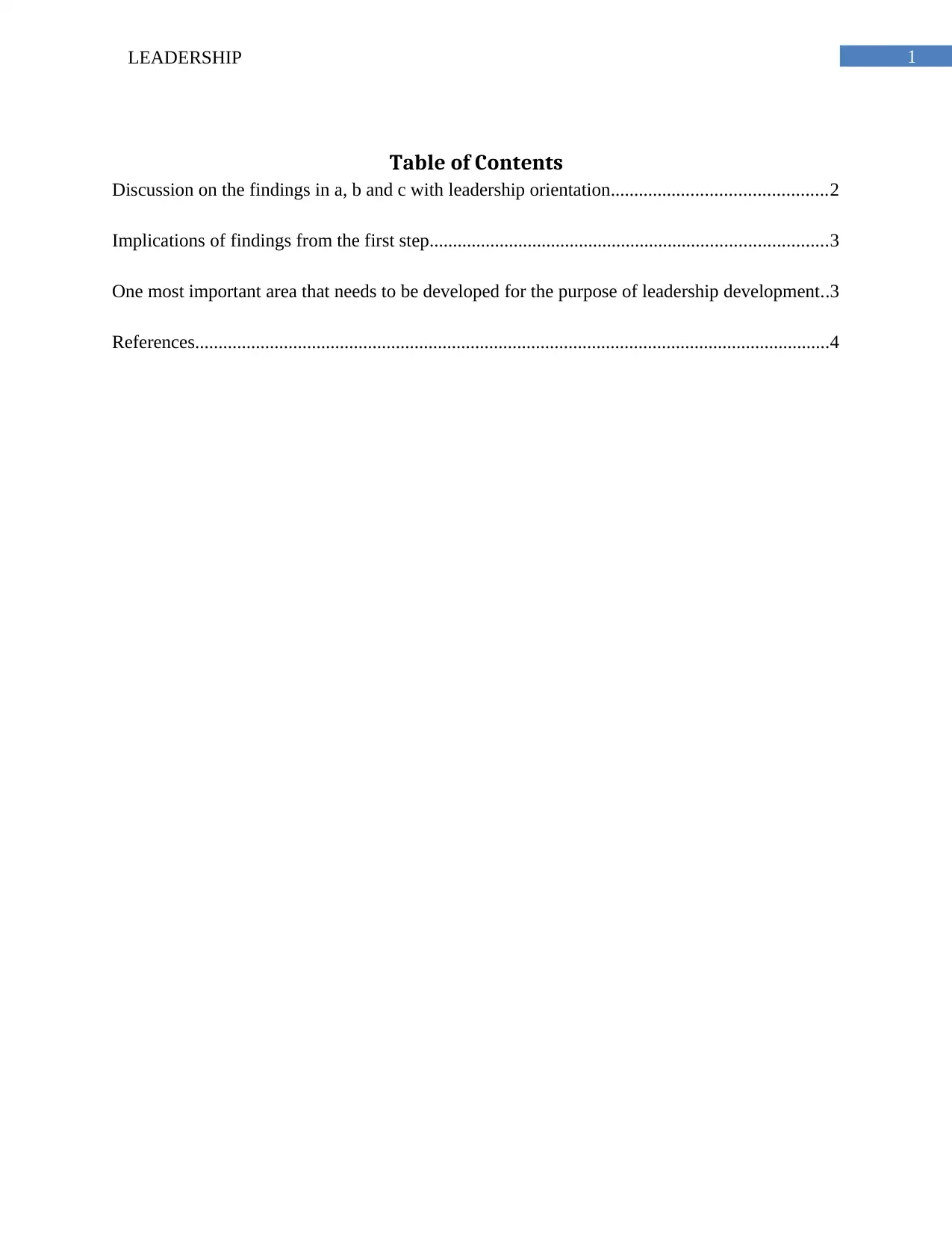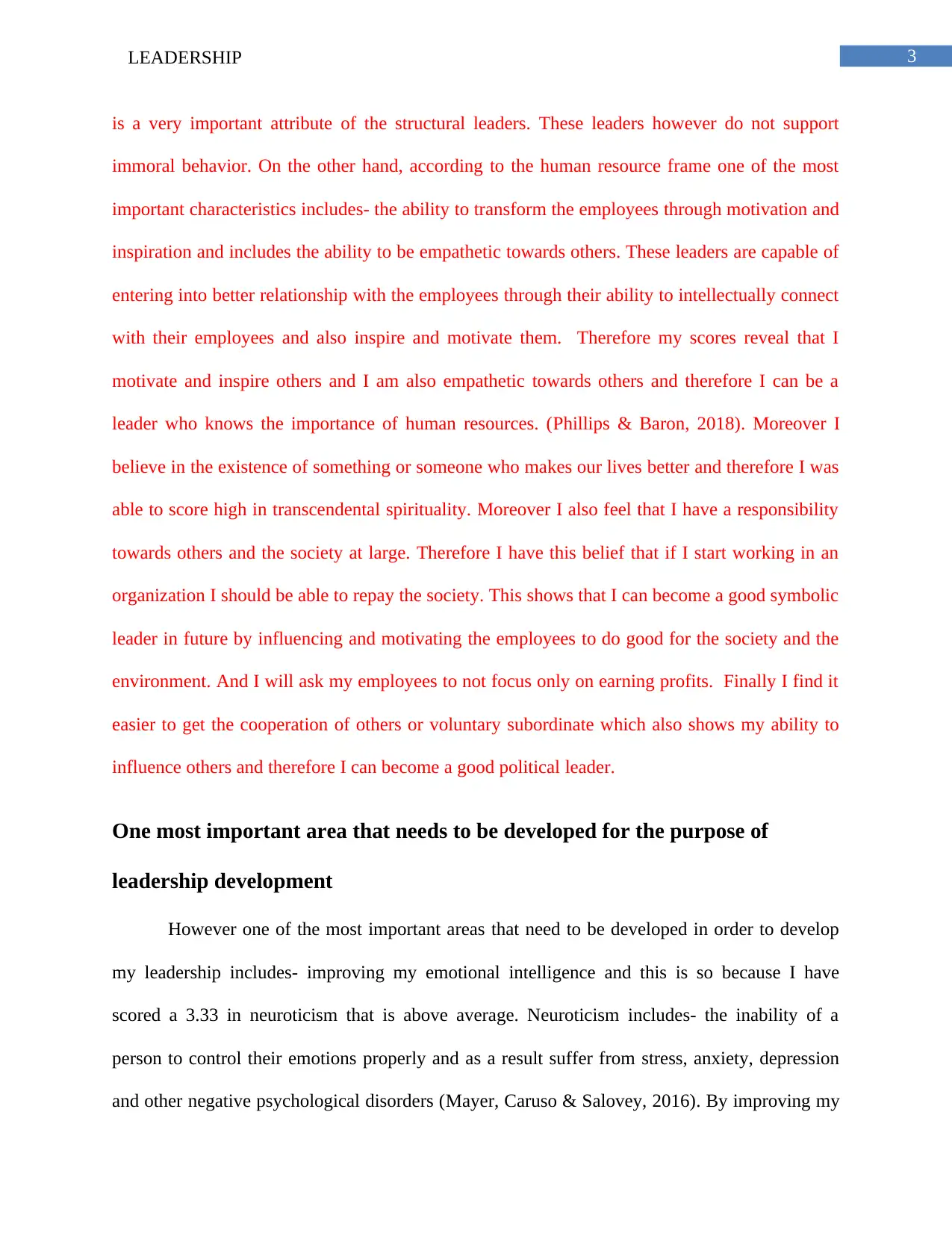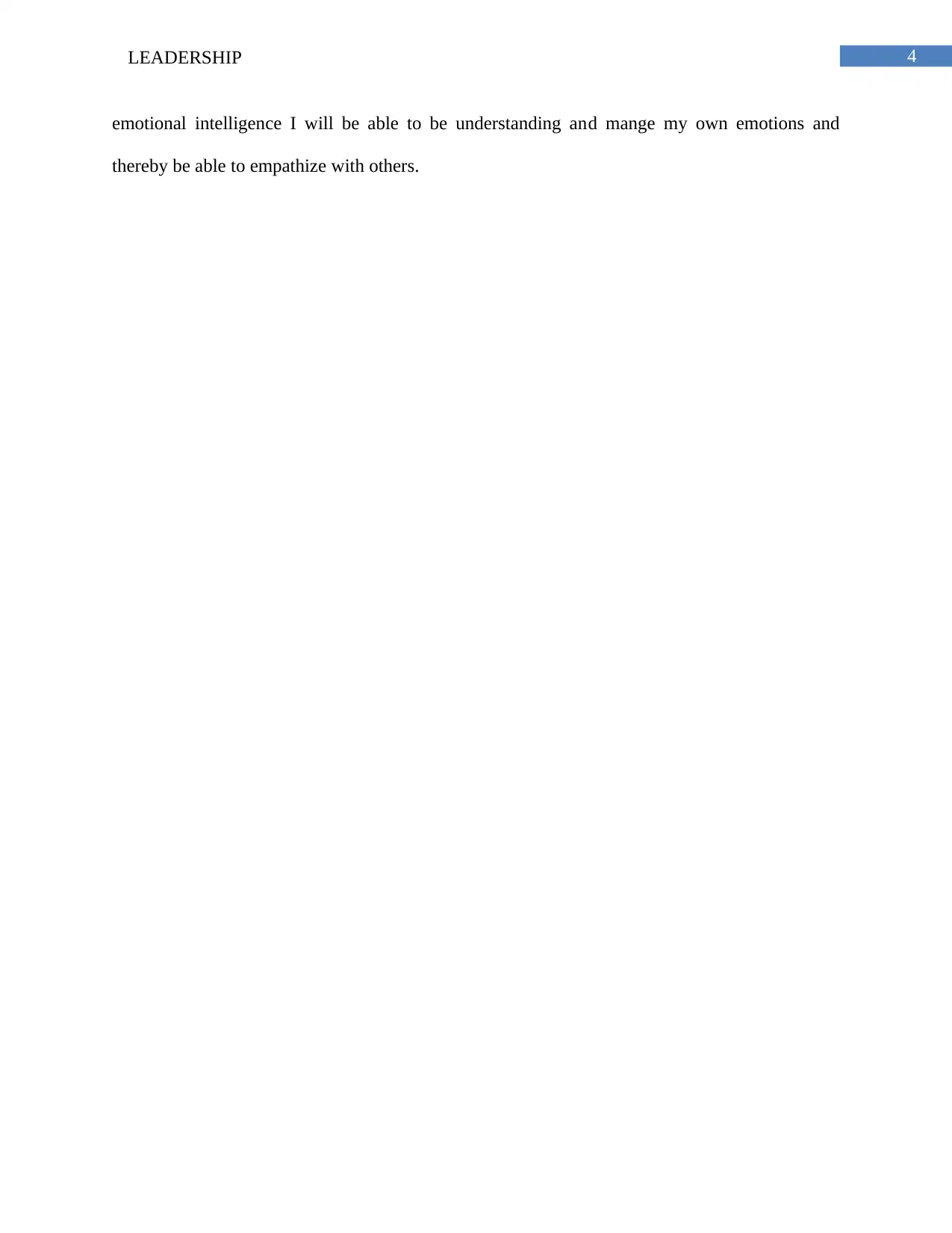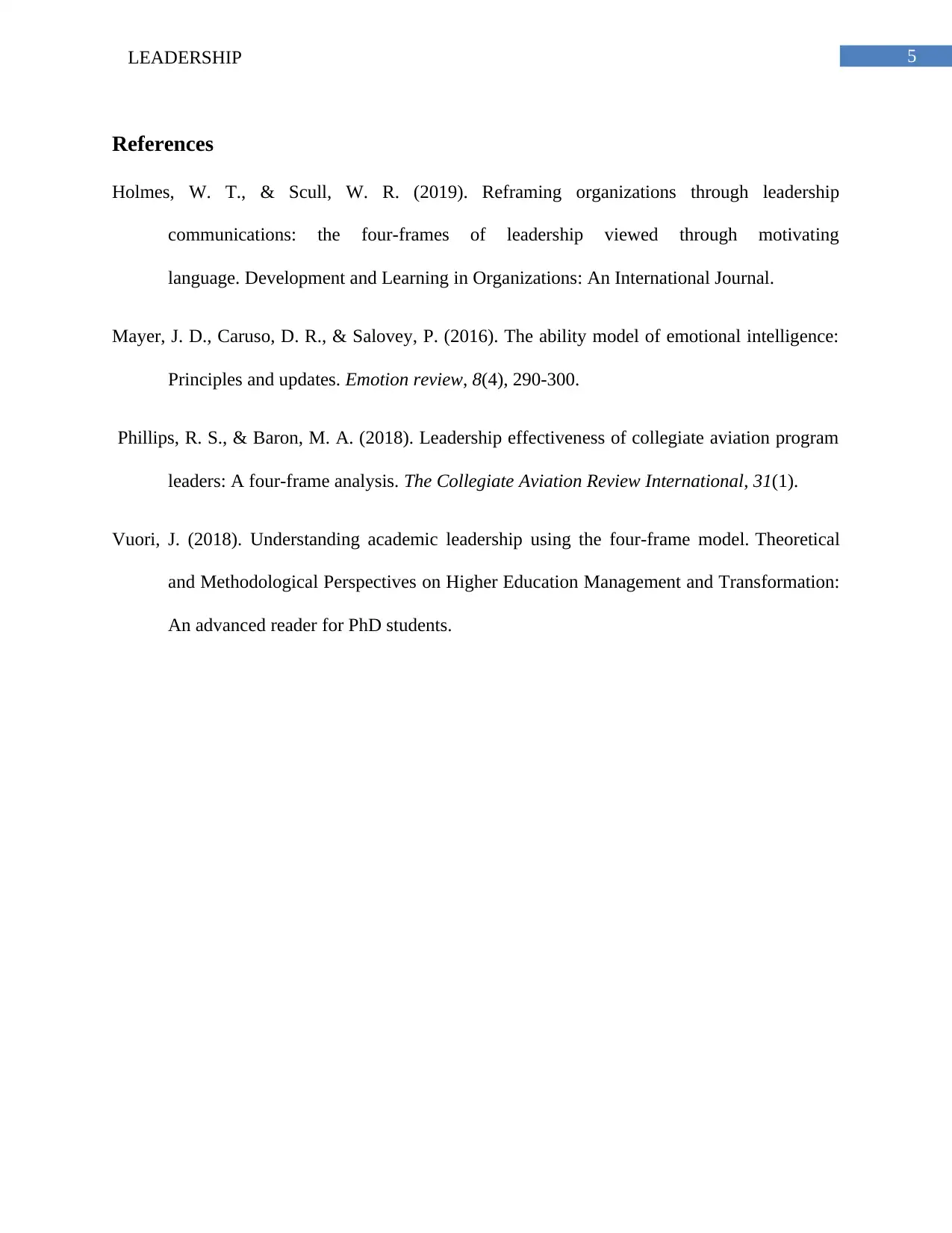Sunway University Leadership Orientation Report, MGT 3073
VerifiedAdded on 2022/08/14
|6
|911
|12
Report
AI Summary
This report provides an analysis of the student's leadership orientation based on the four frames of leadership as defined by Bolman and Deal (1991): structural, human resources, symbolic, and political. The analysis is based on the student's scores from servant leadership, Machiavellian leadership, and Big 5 personality tests. The report discusses the findings in relation to each leadership frame, highlighting strengths and weaknesses. The implications of the findings are explored, with specific suggestions for leadership development, including the importance of improving emotional intelligence to manage emotions and build better relationships. The student's scores are used to explain how they can become a good leader in the future by influencing and motivating employees. The report also includes references to relevant literature.

Running head: LEADERSHIP
LEADERSHIP
Name of Student
Name of the University
Author Note
LEADERSHIP
Name of Student
Name of the University
Author Note
Paraphrase This Document
Need a fresh take? Get an instant paraphrase of this document with our AI Paraphraser

1LEADERSHIP
Table of Contents
Discussion on the findings in a, b and c with leadership orientation..............................................2
Implications of findings from the first step.....................................................................................3
One most important area that needs to be developed for the purpose of leadership development..3
References........................................................................................................................................4
Table of Contents
Discussion on the findings in a, b and c with leadership orientation..............................................2
Implications of findings from the first step.....................................................................................3
One most important area that needs to be developed for the purpose of leadership development..3
References........................................................................................................................................4

2LEADERSHIP
Discussion on the findings in a, b and c with leadership orientation
The four frame of leadership as defined by Bolman and Deal in the year 1991;
organizational experiences are viewed on the basis of different leadership frames or styles. These
frames include- structural, human resources, symbolic and political (Vuori, 2018). Structural
leaders are the one who assign specific roles to the employees and also coordinate their activities
in accordance with specific procedures and a chain of command. Structural leaders are therefore
the one who understand their responsibility and seriousness towards fulfillment of certain
obligations or duties. According to the servant leadership, Machiavellian leadership test and Big
5 personality test, I have scored a 5 in responsible morality, I have scored a 2.4 in amorality and
3.14 in conscientiousness.
Then the second frame of leadership includes human resource frame. The human
resource frame is the ones who aim at developing better relationships with the employees
because they value other feelings and emotions (Holmes & Scull, 2019). According to the test
results of servant leadership, Machiavellian and big five personality test I have scored a 5 in the
transforming influence and 4.29 in agreeableness and a 2.6 in distrust. The symbolic frame
discusses about development of the human behavior through culture and symbols through
sharing of vision and mission. I have scored a 6 in transcendental spirituality, a 3.38 in openness
and 2.3 in desire for control. The political frame leaders are the ones who focus on both group
and individual interests.
Implications of findings from the first step
Therefore according to the model, I always try to fulfill my responsibility towards others
and the same quality can help me in becoming a structural leader. Moreover responsible morality
Discussion on the findings in a, b and c with leadership orientation
The four frame of leadership as defined by Bolman and Deal in the year 1991;
organizational experiences are viewed on the basis of different leadership frames or styles. These
frames include- structural, human resources, symbolic and political (Vuori, 2018). Structural
leaders are the one who assign specific roles to the employees and also coordinate their activities
in accordance with specific procedures and a chain of command. Structural leaders are therefore
the one who understand their responsibility and seriousness towards fulfillment of certain
obligations or duties. According to the servant leadership, Machiavellian leadership test and Big
5 personality test, I have scored a 5 in responsible morality, I have scored a 2.4 in amorality and
3.14 in conscientiousness.
Then the second frame of leadership includes human resource frame. The human
resource frame is the ones who aim at developing better relationships with the employees
because they value other feelings and emotions (Holmes & Scull, 2019). According to the test
results of servant leadership, Machiavellian and big five personality test I have scored a 5 in the
transforming influence and 4.29 in agreeableness and a 2.6 in distrust. The symbolic frame
discusses about development of the human behavior through culture and symbols through
sharing of vision and mission. I have scored a 6 in transcendental spirituality, a 3.38 in openness
and 2.3 in desire for control. The political frame leaders are the ones who focus on both group
and individual interests.
Implications of findings from the first step
Therefore according to the model, I always try to fulfill my responsibility towards others
and the same quality can help me in becoming a structural leader. Moreover responsible morality
⊘ This is a preview!⊘
Do you want full access?
Subscribe today to unlock all pages.

Trusted by 1+ million students worldwide

3LEADERSHIP
is a very important attribute of the structural leaders. These leaders however do not support
immoral behavior. On the other hand, according to the human resource frame one of the most
important characteristics includes- the ability to transform the employees through motivation and
inspiration and includes the ability to be empathetic towards others. These leaders are capable of
entering into better relationship with the employees through their ability to intellectually connect
with their employees and also inspire and motivate them. Therefore my scores reveal that I
motivate and inspire others and I am also empathetic towards others and therefore I can be a
leader who knows the importance of human resources. (Phillips & Baron, 2018). Moreover I
believe in the existence of something or someone who makes our lives better and therefore I was
able to score high in transcendental spirituality. Moreover I also feel that I have a responsibility
towards others and the society at large. Therefore I have this belief that if I start working in an
organization I should be able to repay the society. This shows that I can become a good symbolic
leader in future by influencing and motivating the employees to do good for the society and the
environment. And I will ask my employees to not focus only on earning profits. Finally I find it
easier to get the cooperation of others or voluntary subordinate which also shows my ability to
influence others and therefore I can become a good political leader.
One most important area that needs to be developed for the purpose of
leadership development
However one of the most important areas that need to be developed in order to develop
my leadership includes- improving my emotional intelligence and this is so because I have
scored a 3.33 in neuroticism that is above average. Neuroticism includes- the inability of a
person to control their emotions properly and as a result suffer from stress, anxiety, depression
and other negative psychological disorders (Mayer, Caruso & Salovey, 2016). By improving my
is a very important attribute of the structural leaders. These leaders however do not support
immoral behavior. On the other hand, according to the human resource frame one of the most
important characteristics includes- the ability to transform the employees through motivation and
inspiration and includes the ability to be empathetic towards others. These leaders are capable of
entering into better relationship with the employees through their ability to intellectually connect
with their employees and also inspire and motivate them. Therefore my scores reveal that I
motivate and inspire others and I am also empathetic towards others and therefore I can be a
leader who knows the importance of human resources. (Phillips & Baron, 2018). Moreover I
believe in the existence of something or someone who makes our lives better and therefore I was
able to score high in transcendental spirituality. Moreover I also feel that I have a responsibility
towards others and the society at large. Therefore I have this belief that if I start working in an
organization I should be able to repay the society. This shows that I can become a good symbolic
leader in future by influencing and motivating the employees to do good for the society and the
environment. And I will ask my employees to not focus only on earning profits. Finally I find it
easier to get the cooperation of others or voluntary subordinate which also shows my ability to
influence others and therefore I can become a good political leader.
One most important area that needs to be developed for the purpose of
leadership development
However one of the most important areas that need to be developed in order to develop
my leadership includes- improving my emotional intelligence and this is so because I have
scored a 3.33 in neuroticism that is above average. Neuroticism includes- the inability of a
person to control their emotions properly and as a result suffer from stress, anxiety, depression
and other negative psychological disorders (Mayer, Caruso & Salovey, 2016). By improving my
Paraphrase This Document
Need a fresh take? Get an instant paraphrase of this document with our AI Paraphraser

4LEADERSHIP
emotional intelligence I will be able to be understanding and mange my own emotions and
thereby be able to empathize with others.
emotional intelligence I will be able to be understanding and mange my own emotions and
thereby be able to empathize with others.

5LEADERSHIP
References
Holmes, W. T., & Scull, W. R. (2019). Reframing organizations through leadership
communications: the four-frames of leadership viewed through motivating
language. Development and Learning in Organizations: An International Journal.
Mayer, J. D., Caruso, D. R., & Salovey, P. (2016). The ability model of emotional intelligence:
Principles and updates. Emotion review, 8(4), 290-300.
Phillips, R. S., & Baron, M. A. (2018). Leadership effectiveness of collegiate aviation program
leaders: A four-frame analysis. The Collegiate Aviation Review International, 31(1).
Vuori, J. (2018). Understanding academic leadership using the four-frame model. Theoretical
and Methodological Perspectives on Higher Education Management and Transformation:
An advanced reader for PhD students.
References
Holmes, W. T., & Scull, W. R. (2019). Reframing organizations through leadership
communications: the four-frames of leadership viewed through motivating
language. Development and Learning in Organizations: An International Journal.
Mayer, J. D., Caruso, D. R., & Salovey, P. (2016). The ability model of emotional intelligence:
Principles and updates. Emotion review, 8(4), 290-300.
Phillips, R. S., & Baron, M. A. (2018). Leadership effectiveness of collegiate aviation program
leaders: A four-frame analysis. The Collegiate Aviation Review International, 31(1).
Vuori, J. (2018). Understanding academic leadership using the four-frame model. Theoretical
and Methodological Perspectives on Higher Education Management and Transformation:
An advanced reader for PhD students.
⊘ This is a preview!⊘
Do you want full access?
Subscribe today to unlock all pages.

Trusted by 1+ million students worldwide
1 out of 6
Related Documents
Your All-in-One AI-Powered Toolkit for Academic Success.
+13062052269
info@desklib.com
Available 24*7 on WhatsApp / Email
![[object Object]](/_next/static/media/star-bottom.7253800d.svg)
Unlock your academic potential
Copyright © 2020–2025 A2Z Services. All Rights Reserved. Developed and managed by ZUCOL.




![Leadership Qualities Self Analysis Report - [University Name]](/_next/image/?url=https%3A%2F%2Fdesklib.com%2Fmedia%2Fimages%2Fgz%2F18fd87affd6949e69fb1fcec05fa0d86.jpg&w=256&q=75)
